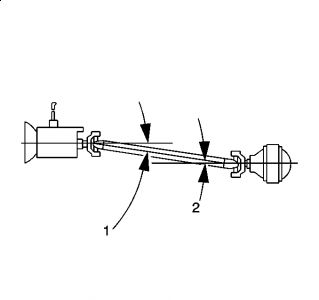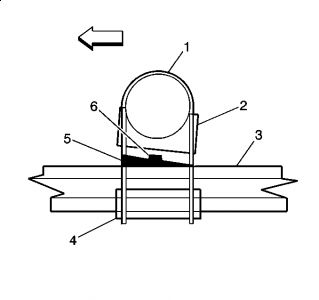I would think that if it were imbalance, or untrue, the vibration would come and go. By that I mean, as it rotates it will reach a speed where it cancels, and reappears. I would think that would occur at higher propshaft speeds and kind of harmonically come and go, not at a launch from a stop. The service bulletin doesn't give any specifics on why it happens, and what changes when going from a 2pc to a 1pc. Does the vehicle fit the criteria of 2500/3500 Ext Cab long box, or Crew Cab short box, does this bulletin even apply. To be honest with you, if the vehicle fit the criteria, and was still under warranty, I would have no hesitation in performing the retrofit from 2pc to 1pc. I will offer you some info on the subject, it can be somewhat complex topic.
Diagnosing Second-Order Driveline Vibration
Second-Order Driveline Vibration Theory
A faulty universal joint (U-joint) may cause a vibration that occurs twice for each rotation of the propeller shaft. This type of vibration is called a second-order vibration.
Second-order driveline vibrations are independent of runout or balance of a driveline component.
The following description of basic U-joint theory will help you to understand where second-order driveline vibrations originate and why they occur.
"� As the propeller shaft rotates, the U-Joint speeds up and slow down twice for each rotation of the propeller shaft.
"� The acceleration and deceleration of the U-Joint is not visible. If there is vibration in the U-Joint, the acceleration and deceleration will be audible and tactile.
"� Compare the U-joint in a vehicle to a universal-type socket. When a universal-type socket is used to tighten a bolt, the socket will bind and release as the socket turns toward 90 degrees. The bind and release occurs twice for each revolution of the socket.
"� The U-joint in a vehicle works in the same way as the universal-type socket. The bind and release effect is directly proportional to the angle that the U-joint operates: the greater the angle, the greater the effect.
"� Because the transmission output speed is constant, the binding and releasing of the U-Joint is better described as an acceleration and deceleration which occurs twice for each revolution of the propeller shaft.
"� If the propeller shaft is running slowly, the accelerating and decelerating effect is visible. The acceleration and deceleration may create a vibration due to the fluctuations in force that are generated at high speeds.
Canceled Out Driveline Angles

(1) Front Working Angle
(2) Rear Working Angle
Engineers design drivelines in order to compensate for the accelerations and decelerations in order to produce a smooth, constant flow of power, as listed below:
"� The transmission drives the front yoke of the propeller shaft at a smooth and constant speed.
"� The first U-joint causes the power to fluctuate twice for each revolution of the propeller shaft.
"� The second U-joint, oriented 90 degrees from the first U-joint, causes the power to fluctuate opposite that of the first U-joint.
"� As the first U-joint slows down, the second U-joint speeds up.
This design causes one U-joint to cancel out the effect of the other U-joint. The cancelled effects result in a smooth, constant power flow from the output yoke of the propeller shaft.
Second-order driveline vibrations occur when the cancellation becomes unequal between the front U-joint and the rear U-Joint.
The main objective of this section is to correct the conditions that interfere with the proper cancellation effect of the U-Joint. The most common condition, especially where the launch shudder is concerned, is incorrect driveline working angles. Other factors may aggravate the condition.
Address the following factors before you attempt to measure or correct the driveline working angles:
"� Worn, failed, damaged or improperly installed U-Joint
"� Worn, collapsed, or improper powertrain mounts
"� Incorrect vehicle trim height adjustment for the front suspension which aggravates the launch shudder
"� Incorrect trim height adjustment for the rear suspension
"� Trim height inspection includes trim heights that are too low or too high. The following vehicles fit into this category:
- Vehicles equipped with aftermarket lift kits
- Vehicles constantly loaded with cargo
- Custom conversion vans
On rear drive vehicles, the pinion nose tilts upward as you lower the rear trim height.
If a second-order driveline vibration exists after you correct these conditions, measure and correct the driveline angles.
If the complaint is present only with cargo in the vehicle, perform the measurements with the vehicle fully loaded. Once you correct a second-order driveline vibration with the vehicle loaded, the vibration may reappear with the vehicle unloaded. The reverse of this condition is also true. You may have to reach a compromise with the customer in this case.
Second-Order Driveline Vibration Symptoms
Second-Order driveline vibration has the following signs and symptoms:
"� The vibration is always related to vehicle speed.
"� The vibration is usually torque-sensitive.
"� The vibration is worse under a torque load.
Launch shudder is the most common complaint of a second-order driveline vibration.
Launch shudder occurs during acceleration from 0-40 km/h (0-25 mph). Launch shudder appears as a low frequency shake, wobble, or shudder. The driver may feel the vibrations in the seat or steering wheel at low speeds of 0-24 km/h (0-15 mph). The vibrations will increase in frequency as the vehicle speed increases. Launch shudder feels more like driveline roughness at higher speeds of 24-40 km/h (15-25 mph). At speeds greater than 40 km/h (25 mph) the vibration usually disappears.
Rear Axle Wind-Up
Rear axle wind-up may cause launch shudder even when all of the working angles are within specifications. Rear axle wind-up occurs when heavy torque during acceleration causes the pinion nose to point upward. In order to compensate for axle wind-up, tip the pinion nose downward. Install the axle shims incrementally, performing a road test after each shim. Add shims until the road test indicates that the shudder is eliminated.
Rear Axle Shims
Wedge shims of different sizes are available through the parts' system and independent suppliers for the purpose of shimming the rear axle angle. Wedge shims are available in 2, 3, and 4 degrees.

(1) Axle Tube
(2) Upper Plate
(3) Spring
(4) Lower Plate
(5) Shim
(6) Button
Caution: Never attempt to shim a rear axle using anything except shims that are designed for this purpose. Failure to do so will result in the shims falling out and a loss of vehicle control and that could cause personal injury.
Install the shims in order to increase or decrease the angle of the rear axle pinion. Install the shims between the leaf spring and the spring seat. Depending on the design of the suspension (leaf spring on top or underneath the axle), and the direction of the desired change, install the shims with either the thick side toward the front of the vehicle or toward the rear of the vehicle.
Important: After installing the shims, ensure that the U-bolt has 2 or 3 threads above the nut. Ensure also that the center bolt, located in the spring seat, is long enough to seat in the locator hole. If these two conditions do not exist, use longer U-bolts and center bolts. Longer U-bolts and center bolts are available through local spring shops.
Wednesday, March 31st, 2010 AT 11:22 PM




